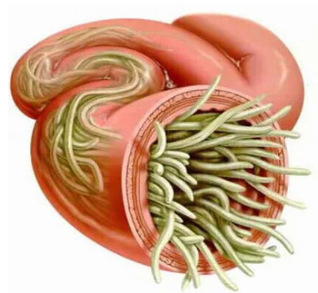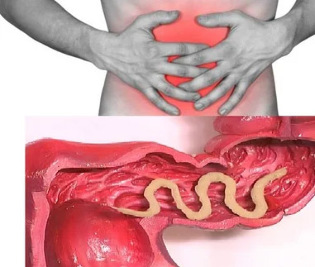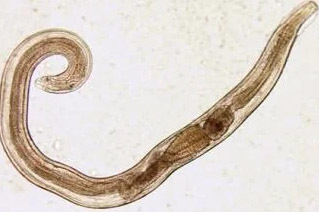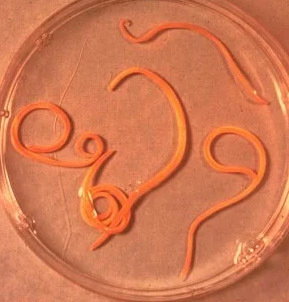On today's science known the order of 280 species of worms that are able to evolve and live in the human body, the disease in the various organs and tissues. The frequency of infection with worms of a person depends on the climatic and socio-economic conditions of specific territories (in the underdeveloped countries, especially in those, which are located in tropical and subtropical areas, the level of parasitic infection was significantly higher than in economically developed states).
Ways of human infection with worms:
- Bioelements (infection from animals).
- Contagious helminthiasis (transmissible from person to person).
- Geohelminthiasy (a disease caused by parasites, the conductive one of the life cycles on earth).

Factors that influence the manifestations of helminths
Way of penetration of the parasite into your body:
- The degree of adaptation of the helminth to the human body;
- Population density (the number of) parasitic individuals;
- The location of the worm (cloth parasites live in the deep soft tissue, and translucent live in the lumina of hollow organs). Some helminths in different stages have and the translucent substance and shape. Larvae and development stage of the worms, as usual, causing more expressed pathological changes.
In the absence of reinfection, the number of adult parasites in the human body will increase. This feature significantly differentiates worm infestations from diseases caused by bacteria, viruses, fungi and protozoa organisms.
Worms in humans: symptoms
Helminthiasis is a disease for which there is a typical 2-phase flow (acute, from two weeks to two months) and chronic (from several months to several years).
Symptoms of the acute phase of helminthiasis
The first symptoms of the disease may show itself at various intervals (most commonly 2-3 weeks, in ascariasis – in 2-3 days, but when filariose incubation period can last 6-18 months).
In the acute phase of helminth parasitic disease the most characteristic symptom is an allergic reaction (going private of antibodies to antigens migrating larvae of parasites). Often in infected worms the people on the skin appear itchy rash, are prone to retidiviruuschem flow, increasing the regional lymph nodes, it is possible occurrence of generalized helena local swelling, muscle and joint pain. Also the migrating larvae of the parasite can cause pain in the chest area, cough, shortness of breath, disorders stool, nausea and vomiting.
At the same time the acute phase of helminthiasis can be accompanied by serious disabilities (severe forms of pneumonia, hepatitis, allergic myocarditis, hepatosplenomegaly (enlarged liver and spleen).
In the blood, an increase in the number of eosinophils (eosinophilia) and is disturbed by the normal quantitative relationship between the protein fractions (dysproteinemia).

Symptoms of chronic helminthiasis
The symptoms of the chronic phase is directly dependent on what authority is "inhabited" the parasites, but also the important role played by their size and number.
So when parasitism in the intestines of the individual subjects of the disease may be asymptomatic (with the exception of the cases of infection a very large parasites). The characteristic symptoms of chronic phase of intestinal helminths are dyspeptic disorders. In children to a greater extent expressed asthenoneurotic and painful. During the massive assault on Ascaris perhaps the development of intestinal obstruction, mechanical jaundice and pancreatitis.
Consumes everything necessary for their waste products from your body of the host, helminths are the cause of digestive disorders, disorders of absorption of vitamins, minerals, carbohydrates, proteins and fats. At the same time the waste products of worms to annoy the normal microflora of the intestine and reduce the immune strength of your body.
In people suffering from helminthiasymi, due to weakened immunity and increased the process of cell division (a result of the continuous recovery of damaged tissues parasites), significantly increases the risk of developing malignant tumors.
Types of worming, parasitic in the human body
Representatives of helminths person are 2 types of worms: round (hookworm) and flat (tapeworm and happiness).
Roundworms
Threadworm
Parasites are the cause of enterobiasis – it is small (to 10 mm) thin abdominal worms, which have a grayish-white spots. Injection is happening alimentary route (through the mouth). Reason – dirty hands. Parasite eggs can be in the country, the waves of infected animals, unwashed vegetables and fruits, etc. Along with the in the on enterobiasis there are many cases samsarajade (especially in children), resulting from scratching the itchy areas and the subsequent ingestion of the eggs. The Larva pinworms develops in the course of two weeks in the digestive tract. Changes in adult worm parasite in the lower parts of the small intestine and the upper part of the colon.

Ascaris
Ascaris is the largest parasite fusiform forms a reddish-yellow color, reaching in the adult condition 40 cm (female) and 15-25 cm (males). Do not have infants helena other connected products, Ascaris is able to independently move towards the food of the masses. Eggs, a waiting woman of the parasite are excreted along with the feces.
Assault ascariasis happens in the case of ingestion of mature egg along with the water helena unwashed vegetables and fruits, on which they are available in different soils. After the penetration of eggs into the intestine of them have a view of mature larvae. Then, taking the roots into the wall of the intestine, that is, on the bloodstream to reach the heart, and from there they get into the lungs. Through the pulmonary alveoli larva of the roundworm on the airways again penetrates into the oral cavity. After re-ingestion of the parasite reaches the small intestine, where it develops in adulthood the individual. The worm lives for a period of 12 months, furthermore, it is killed and is excreted along with the feces. In the intestines of a single host can live as one, and several hundred individuals.
Whipworm
Whipworm, the causative agent of trichuriasis is worms white color, parasitic in the initial separation of the colon and reaches the size of 4-5 see the parasite Feeds on the blood and tissues of the mucous membrane of the rectum.
Whipworm Eggs, deferred the woman on the walls of the intestines, they go out together with the fecal masses. Their development takes place in the environment (optimally – in the soil). Eggs to Mature in them the larvae of the parasite penetrate into your body alimentary route, through dirty hands, with water helena unwashed vegetables and fruit.

Trichinella
The causative agent of trichinosis – this is a gentle whole worms, reaching 2-5 mm in length. Infection occurs when eating poorly roasted meat (pork, bear meat, boar helena). Penetrates into the intestine, the larva of the parasite in 3-4 days there is a period of ripening until the state of the Mature individuals. The length of life of the worms is 40 days, after which the parasite dies. Prosurvival intestinal wall, the larvae penetrate the bloodstream and posted on all the organs of the human your body, settling in the muscles. In this case, most often affects breathing and facial muscles as well as muscles-flexors of the limbs.
In the first days after the assault sufferers complain of abdominal pain. Then, after about 2 weeks, the body temperature increases up to 39-40 C, the skin will appear itchy rash, they develop muscle pain, swells the face. In this period, in the case of a massive assault, there is considerable risk of lethal outcome. About a month recovery. The parasite was demonstrated in the spiral shape, after which in two years will die.
Ancylostoma and necator
These two parasite are similar among themselves on the biological characters, as well as for the party name diseases. With relation to this, it is decided to merge under the common name (hookworms). The worms reached a length of 10-15 mm, parasitic in the 12-gp in the intestine. It should be noted that this is one of the most common, but at the same time, quite rarely identify the parasites. The larvae of the worms penetrate into the organism through the skin veils when in contact with infected soil. Further, to get into circulation, they are, like the roundworm, who migrate to the lungs, and then, through the bronchi, together with otharkivajushche sputum – in the digestive tract. Ancylostoma parasite in the intestine, by the intestinal wall. A parasite, eating exclusively blood, bites piercings lining the blood vessels, Squirting there an anticoagulant ingredient. Per night adult on average can absorb of 0.05-0.35 ml of blood. So the most characteristic symptom of this helminthiasis is iron deficiency anemia, as well as changes in the ratio of protein fractions (dysproteinemia).
Flat worms
Broad tapeworm
This is one of the largest deworming, often in a length of 10 to 20 meters. The disease, caused by the data parasite is called difillobotrioz. The development cycle of worms begins with the freshwater fish helena crustaceans. Into your body, the person who is the ultimate host to a wide tasemnicea, the larva gets together with caviar helena the infected fish fillets. Reach the small intestine, the parasite is attached to its wall, and after 20-25 days to grow into Mature individuals.
Liver Fluke
The parasite, which opisthorchiasis – it is a flat worm, reaching a length of 7-20 mm. it should Be noted that more than 50% of cases of the disease the liver Flukeom (but it is called cat Fluke) falls on the inhabitants of Russia. The larvae of the parasite begins to develop after the impact of the eggs in fresh water (from swallowing their snails). To further penetrate into your body fish (carp, carp, bream, roach). An aggravated assault occurs when the consumption in food of the infected fish flesh, not of the past sufficient thermal processing. The Larva of the liver Flukea of the small intestine penetrates into the biliary ducts and gall bladder, fastening there to help the two infants.
Bullish and pig tapeworm
These almost identical in its structure the parasites reach a length of 5-6 meters. Assault beef tapeworm infection and teniasis occurs due to the consumption of meat of bovine animals and pig meat infected with the Finns (one of the sub-forms of helminthiasis). Viable finns, presented in the form of whitish bubbles reach the size of 0.5 cm, are attached to the wall of the small intestine of man and for 3 months turns into an adult individual. The belt is a parasite, which consists of more than 2000 segments, is constantly growing. In this end-segments, containing eggs, rip and yourself move to the large intestine to the anal opening, and then crawls out of the anus, helena are excreted into the external environment along with the feces. The most characteristic symptoms of helminthiasis is the disruption of the functioning of the digestive tract.
Echinococcus
For this parasite, man is the intermediate host. Worm parasite in the human body in the form of the finns. The definitive host of the Echinococcus – a wolf, a dog, helena cat. Infection occurs alimentary by being in contact with animals and with objects of the environment, seeding the eggs of Echinococcus. After falling into the guts of them are developing oncospheres (shestigrannye larvae). From the intestine penetrate into the bloodstream and published throughout your body.
Alveolar
This parasite, which is considered a sort of Echinococcus, is the reason why one of the most dangerous helminths (from alveococcosis), which, according to the severity of the course of is similar with cirrhosis and liver cancer. Infection occurs when the penetration of oncospheres (eggs to Mature larvae) in the intestine. There the embryo comes from the egg and put down roots into the intestinal wall, penetrates through into the bloodstream. Further, with the flow of blood parasite spreads to all tissues and organs of your body (most often localized in the liver). There, the larvae begins with the main stages of development (forming Multicam bubble, labrocyte). In each cell is contained uterine crown of the parasite, which continues to develop gradually. Eurocity – it is a very aggressive shaping, continuously growing through the increase of bubbles, as well as have the ability to germinate on the liver, as well as cancer metastasis.
Diagnosis of helminths
Diagnosis of worm invasion includes the following activities:
- a careful collection of medical history, we help figure out possible causes of the disease;
- laboratory studies of feces, blood, content, 12p colon, rectal and perianal mucus, muscle tissue, lung mucus, bile. When carrying out the analysis can be identified by the eggs, the segments of the helen fragments of the parasite. However, the increased content of eosinophils in the blood is also a signal about the availability of helminthiasis.
- in the diagnosis of disease caused by the larvae stages of the helena cloth parasites, are serological tests (ELISA, CANCER, reaction of indirect agglutination, immunofluorescence analysis, etc.).
- for the identification of de-worming, that attack the liver tissue, is hereby appointed as ULTRASOUND, CT and endoscop - diffraction warehouse.
Worms in humans: treatment
In the acute phase parasitarias infection, the patient is assigned to detoxication and desensitizing therapy. When a heavy course of the disease (on the trematode of the liver, trichinosis) on the medical testimony are used glucocorticoids.
As the medications specific therapy taking into account the nature of the pathogen are assigned special rotteveelintie Khimiterrett - diffraction means.
In parallel, the patient was recommended intake of antihistamines and enterosorbents. The final stage of treatment involves the use of probiotics, normalizing the microflora of the intestines.
It is also assigned to the special sparing diet (food should be easily digestible and contain little fats).
In the period pprotivoglistnoe therapy from the patient is required strict adherence to personal hygiene (to prevent re-infection). At the same time, when many helminthiasyx treatment must go through all the family members and persons living with the infected in constant contact.






































